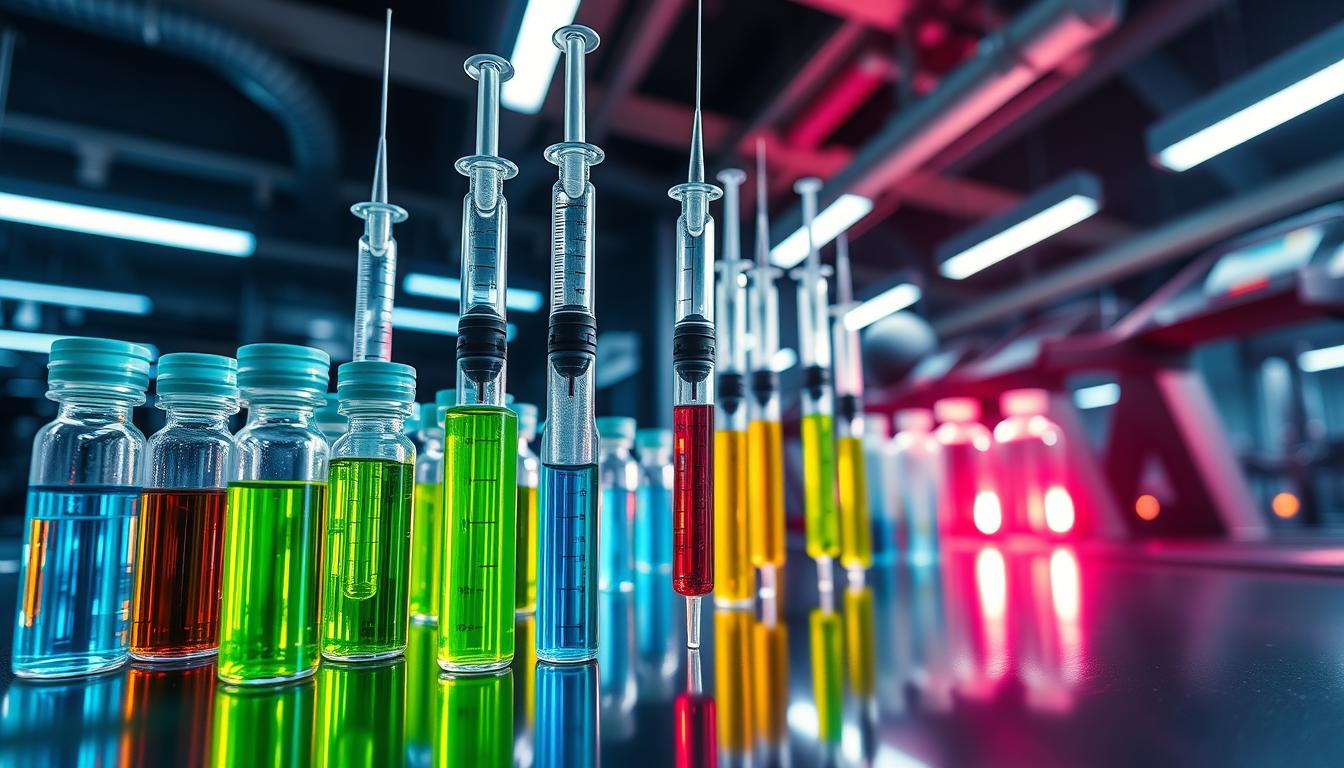Banned but Effective: Why Peptides and SARMs Are Off-Limits in Athletics

In the world of competitive sports, every advantage counts. Athletes look for ways to perform better, recover quicker, and stand out. Peptides and Selective Androgen Receptor Modulators (SARMs) offer such benefits but are banned. Why have these substances been outlawed in professional athletics?
Performance-enhancing drugs (PEDs), like anabolic-androgenic steroids (AAS), have long been a problem in sports1. These steroids are controlled substances in many countries, including Australia, Argentina, Brazil, Canada, the United Kingdom, and the United States1. It’s hard to know how common their use is, but reports show many gym-goers and competitive bodybuilders have tried them1.
In response, the International Olympic Committee banned anabolic steroids in 1974. The World Anti-Doping Agency (WADA) was created in 1999 to fight doping in sports1.
Key Takeaways
- Peptides and Selective Androgen Receptor Modulators (SARMs) are banned in professional sports because of their misuse potential.
- Anabolic-androgenic steroids (AAS) are the most used PEDs, with many gym-goers and athletes using them.
- The International Olympic Committee and the World Anti-Doping Agency have led the fight against doping, banning anabolic steroids since 1974.
- The U.S. Food and Drug Administration (FDA) has warned about the serious health risks of SARMs, including heart attack, stroke, and liver damage.
- It’s hard to stop the use of banned substances, with the black market and social media making them more accessible.
Understanding SARMs and Peptides: A Scientific Overview
To explore the world of performance-enhancing substances, we need to know about SARMs and peptides. SARMs are synthetic compounds that act on androgen receptors. They can be full, partial agonists, or antagonists2. These substances are more effective orally and target specific tissues, unlike traditional steroids. They also don’t convert to harmful hormones, which may reduce side effects2.
Chemical Structure and Mechanism of Action
Differences Between SARMs and Traditional Steroids
SARMs are more selective than traditional steroids in hormone regulation. While steroids can cause health problems, SARMs aim for a safer profile. Yet, their long-term safety is still being studied2.
Common Types of Performance Enhancers
Peptides are also popular in bodybuilding for performance enhancement. They help the body produce more hormones naturally. This can be good for muscle loss, osteoporosis, and cancer2.
| Substance | Description |
|---|---|
| SARMs | Synthetic ligands that selectively target androgen receptors, promoting anabolic effects on muscle and bone while minimizing androgenic side effects. |
| Peptides | Substances that stimulate the body’s natural hormone production, with potential applications in treating conditions like muscle wasting and osteoporosis. |
The use of SARMs and peptides in sports and bodybuilding is debated. These substances are banned by many due to health concerns2. Knowing how they work is key to understanding hormone regulation and muscle growth.
The Evolution of Performance Enhancement in Sports
The quest for top athletic performance has always been linked to using performance-enhancing substances. Sports history is filled with doping scandals that have tested the limits of athletic performance. From the first tries with stimulants to today’s advanced doping methods, the world of sports has changed a lot.
The creation of synthetic testosterone in the 1930s was a big step. It led to its wide use in sports by the 1950s4. This change started a time when athletes wanted to go beyond their limits, often risking fairness and safety.
The International Olympic Committee banned doping in 1967, starting a game of catch-up between those who dope and those who try to stop them. The 1990s and early 2000s saw the rise of designer steroids, highlighted by the BALCO scandal, which made anti-doping efforts even harder5.
Now, the fight is about SARMs and peptides. These substances offer performance benefits with fewer side effects than old steroids, making them more appealing to athletes looking for an advantage6.
As sports history goes on, the battle between those who dope and those who try to stop them keeps changing. The doping scandals that have shaken sports remind us of the importance of staying alert and striving for true athletic greatness.

“The evolution of sport and society suggests that allowing PEDs could be a natural progression, akin to the evolution of paying athletes for their talents.”
Why Peptides and SARMs Are Banned in Sports
Impact on Fair Competition
Health and Safety Concerns
Regulatory Compliance Issues

Health Risks and Side Effects of SARMs Usage
Selective Androgen Receptor Modulators (SARMs) are seen as safer than traditional steroids. But, they still pose health risks in sports. Studies and user reports show SARMs can lower testosterone, change cholesterol, and harm the liver10. Even small doses can lower good cholesterol and raise heart risks10.
| Potential Side Effects of SARMs | Impact on Athletes |
|---|---|
| Hormonal imbalances, liver damage, cardiovascular risks | Compromised health, decreased performance, long-term health concerns |
| Headache, nausea, fatigue, back pain | Reduced recovery, impaired training and competition |
| Endocrine disruption, liver toxicity | Physiological changes that negatively affect overall health and athletic performance |
Using SARMs in sports is wrong and dangerous for athletes. The World Anti-Doping Agency (WADA) has banned them. Athletes caught using them face harsh penalties, like suspensions and bans9.

“The use of SARMs is not only unethical, but it also puts athletes’ health at serious risk. The long-term effects of these substances are still largely unknown, and the potential for harm is simply not worth the potential performance benefits.”
The Black Market and Accessibility Problems
The black market for illegal supplements, like SARMs and fake drugs, is a big worry in sports. A study showed that only 52% of 44 products labeled as SARMs actually had the right stuff. The rest had unapproved drugs or extra substances12. This means users might get sick from bad or fake products.
Quality Control Issues
Legal Implications of Purchase and Use
Underground Distribution Networks
“Misleading information was reported on most websites, with statements like ‘for research only’ despite indications on dosage and training phases.”12
Anti-Doping Regulations and Testing Protocols
Anti-doping groups use advanced tests, like urine and blood checks, to find banned substances in athletes’ samples14.
The Impact on Athletic Performance and Recovery
Performance-enhancing substances like SARMs and peptides are getting more attention in sports. They could give athletes an edge, but they’re banned because of fairness, health, and rules17.
Muscle Growth and Strength Gains
Recovery Enhancement Properties
SARMs and peptides can also improve recovery. They boost muscle growth and protein synthesis. This means athletes might recover faster from hard training and injuries17. But, it’s hard to know how much of a difference they make in real sports because of research limits.
Performance Metrics
The benefits of SARMs and peptides for sports are clear, but their effects on specific skills vary. The substance, dosage, and how each person reacts can affect performance17.
It’s important to remember that using these substances is banned in most sports. This is because of fairness, health concerns, and rules17. Even though they might improve performance, the risks and ethics make them wrong for competitive sports.
“The use of SARMs and peptides has become a growing concern in the world of sports, as these substances can provide athletes with a significant competitive advantage, but at the cost of fairness, health, and regulatory compliance.”
Alternatives to Banned Substances in Sports
SARMs and peptides are banned in sports, but there are safe alternatives. Legal and natural ways to boost performance exist without health risks or disqualification18. Good nutrition, smart training, and recovery methods can enhance performance naturally.
Good nutrition is essential for athletes. Eating enough protein and carbs at the right times helps muscles grow and recover18. Supplements like creatine, beta-alanine, and caffeine are legal and can give athletes a natural edge.
Using advanced training methods is also key19. Periodization and HIIT can unlock an athlete’s full potential. Periodization helps the body adapt and improve, while HIIT boosts fitness and fat burning.
Recovery is just as important as training19. Sleep, massage, and cryotherapy reduce inflammation and aid muscle repair. They help athletes perform better without banned substances.
“The true essence of sport lies in the pursuit of excellence through hard work, dedication, and unwavering determination – not in the exploitation of banned substances that undermine the integrity of competition.”
Conclusion
The use of banned substances like SARMs and peptides in sports is a big challenge. These substances can improve performance but pose serious health risks and threaten fair play20. For example, BPC-157, a synthetic peptide, is not safe for humans and its health effects are still unknown because of few studies20.
Stopping the misuse of performance-enhancing drugs needs a team effort from many groups21. Criminal groups are getting into sports, selling banned substances and finding ways to get around the law21. We need stronger rules, better ways to detect drugs, and more openness to keep sports fair and safe.
It’s important for athletes, coaches, and doctors to keep up with new research on performance boosters20. False claims and the marketing of substances like BPC-157 as “research chemicals” show we need more education20. By working together and focusing on athlete health, we can make sports fair, safe, and true to its values.
FAQ
What are SARMs and peptides, and why are they banned in sports?
SARMs and peptides are synthetic substances used for muscle growth and fat loss. They are banned by WADA because they give athletes an unfair advantage. They also pose health risks.
How do SARMs and peptides work, and how do they differ from traditional steroids?
SARMs bind to androgen receptors, unlike traditional steroids. They have high oral bioavailability and selective anabolic activity. Peptides stimulate natural hormone production, like growth hormone-releasing peptides.
How has the use of performance-enhancing substances evolved in sports history?
Performance enhancement in sports started with stimulants in the early 20th century. Synthetic testosterone in the 1930s led to widespread use by the 1950s. The IOC banned doping in 1967, starting a cat-and-mouse game. SARMs and peptides are the latest challenge.
What are the main reasons for the prohibition of SARMs and peptides in sports?
They give athletes an unfair advantage by enhancing muscle and recovery. There are health concerns due to unknown long-term effects. It’s hard to detect them because they’re sold as research chemicals online.
What are the potential health risks associated with the use of SARMs?
SARMs can lower testosterone, change cholesterol levels, and harm the liver. They may increase heart disease risk. Side effects include headaches, nausea, and fatigue. Long-term use can cause hormonal imbalances and liver damage.
What is the current landscape of the illicit market for SARMs and peptides?
SARMs are legal to sell as research chemicals but illegal for human use. Underground networks sell them online. Many products are unapproved, posing risks to users. Their availability and perceived safety lead to widespread use.
How do anti-doping organizations detect and regulate the use of SARMs and peptides?
WADA updates the List of Prohibited Substances annually. Anti-doping organizations use urine and blood tests to detect them. New compounds and short detection windows are challenges. Athletes face strict testing policies.
What are the performance-enhancing effects of SARMs and peptides?
SARMs like Ostarine increase lean body mass and may reduce fat. They enhance muscle protein synthesis for faster recovery. However, the real-world benefits are hard to measure due to ethical research constraints.
What are some legal and safe alternatives to SARMs and peptides for athletes seeking performance enhancement?
Legal supplements like creatine and caffeine have proven benefits. Advanced training and recovery methods are also effective. A holistic approach to athletic development is recommended.
Source Links
- https://pmc.ncbi.nlm.nih.gov/articles/PMC10759908/ – The Uses of Anabolic Androgenic Steroids Among Athletes; Its Positive and Negative Aspects- A Literature Review
- https://health.clevelandclinic.org/sarms-harmful-side-effects-and-risks – The HARM of Taking SARMs
- https://www.uspharmacist.com/article/recreational-use-of-selective-androgen-receptor-modulators – Recreational Use of Selective Androgen Receptor Modulators
- https://pmc.ncbi.nlm.nih.gov/articles/PMC4026349/ – Adverse Health Consequences of Performance-Enhancing Drugs: An Endocrine Society Scientific Statement
- https://www.britannica.com/procon/sports-and-drugs-debate – Sports and Drugs | Pros, Cons, Debate, Arguments, Performance-enhancing, Steroids, Olympics, Professional Sports, & Doping | Britannica
- https://www.cnn.com/2013/02/07/sport/australia-doping-explained/index.html – Cheating in sport: What are banned substances? | CNN
- https://www.usada.org/spirit-of-sport/research-chemicals-athletes-risk/ – Research Chemicals: A Worrying Trend Putting Athletes at Risk
- https://www.ncaa.org/sports/2015/6/10/ncaa-banned-substances.aspx – NCAA Banned Substances
- https://sportintegrity.nz/news/the-truth-about-sarms – SARMS: Unsafe. Illegal. Banned in sport.
- https://www.thermofisher.com/blog/analyteguru/peds-and-the-olympics-the-allure-of-sarms/ – PEDs and the Olympics: The Allure of SARMs
- https://www.usada.org/athletes/substances/effects-of-performance-enhancing-drugs/ – Effects of Performance-Enhancing Drugs | USADA
- https://pmc.ncbi.nlm.nih.gov/articles/PMC10973938/ – Illegal products containing selective androgen receptor modulators purchased online from Italy: health risks for consumers
- https://www.abc.net.au/triplej/programs/hack/massive-blackmarket-in-sarms-research-chemicals/9666006 – SARMs: The massive black market in illegal bodybuilding ‘research chemicals’ – triple j
- https://www.wada-ama.org/sites/default/files/resources/files/2016-09-29_-_wada_prohibited_list_2017_eng_final.pdf – PDF
- https://ifbb.com/the-prohibited-list/ – THE PROHIBITED LIST
- https://cces.ca/banned-substances-and-methods – Banned Substances and Methods | Canadian Centre for Ethics in Sport
- https://www.ncbi.nlm.nih.gov/books/NBK305894/ – Performance Enhancing Hormone Doping in Sport – Endotext
- https://www.healthline.com/nutrition/peptides-for-bodybuilding – Peptides for Bodybuilding: Do They Work, and Are They Safe?
- https://www.abc.net.au/news/2013-02-07/explainer-performance-enhancing-substances/4506126 – From peptides to hormones: doping drugs explained
- https://www.usada.org/spirit-of-sport/education/bpc-157-peptide-prohibited/ – BPC-157: Experimental Peptide Creates Risk for Athletes
- https://www.medsafe.govt.nz/consultations/acc-pieds.pdf – Organised Crime and Drugs in Sport












